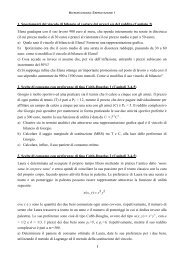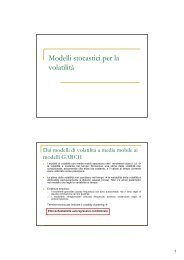Teoria della selezione del portafoglio e modelli di equilibrio del ...
Teoria della selezione del portafoglio e modelli di equilibrio del ...
Teoria della selezione del portafoglio e modelli di equilibrio del ...
Create successful ePaper yourself
Turn your PDF publications into a flip-book with our unique Google optimized e-Paper software.
Per <strong>di</strong>mostrare che anche nel secondo caso l'utilità attesa è funzione <strong><strong>del</strong>la</strong> me<strong>di</strong>a e <strong><strong>del</strong>la</strong><br />
2<br />
varianza si utilizza la funzione quadratica ux ( )= ax 1 −ax<br />
2 con a2 parametro positivo e<br />
quin<strong>di</strong> si attuano i seguenti passaggi:<br />
2<br />
2<br />
2 2 2<br />
Eux = Eax− ax = aE x − aE x = aE x − a E x + σ = f E x,<br />
σ<br />
[ ( ) ] [ 1 2 ] 1 ( ) 2 ( ) 1 ( ) 2 ( )<br />
che con la legenda <strong><strong>del</strong>la</strong> <strong>selezione</strong> <strong>del</strong> <strong>portafoglio</strong> <strong>di</strong>venta:<br />
EuR ( )<br />
2<br />
= EaR− aR<br />
2<br />
= aE R − aE R =<br />
111<br />
( [ ] ) ( ( ) )<br />
[ ] [ 1 2 ] 1 ( ) 2 ( )<br />
= aE( R) − a<br />
2 2 [ E( R) ] + σ<br />
2<br />
= f( E R,<br />
σ )<br />
1 2<br />
( ) ( )<br />
Nella <strong>selezione</strong> <strong>di</strong> <strong>portafoglio</strong> secondo il metodo E-V si deve, per in<strong>di</strong>viduare il <strong>portafoglio</strong><br />
ottimo, o adottare come ipotesi <strong>di</strong> base una funzione <strong>di</strong> utilità quadratica o ipotizzare una<br />
<strong>di</strong>stribuzione Gaussiana dei ren<strong>di</strong>menti futuri.<br />
Ritornando all'analisi <strong>di</strong> <strong>portafoglio</strong> tramite l'utilizzo <strong>del</strong>le frontiere efficienti, si può<br />
considerare l'utilità attesa funzione <strong>del</strong> ren<strong>di</strong>mento atteso e <strong>del</strong> rischio <strong>di</strong> <strong>portafoglio</strong> e<br />
massimizzarla per in<strong>di</strong>viduare il <strong>portafoglio</strong> ottimo.<br />
Ciò può avvenire riportando i valori <strong><strong>del</strong>la</strong> funzione <strong>del</strong>l'utilità, funzione <strong>di</strong> E e V, associando<br />
ad ognuno <strong>di</strong> essi una curva <strong>di</strong> in<strong>di</strong>fferenza quadratica in E-V (nel caso, circonferenza con<br />
centro sull'asse dei ren<strong>di</strong>menti).<br />
8.4.1 Critero <strong>di</strong> scelta: la funzione <strong>di</strong> utilità e le curve <strong>di</strong> in<strong>di</strong>fferenza in E-V<br />
La funzione <strong>di</strong> utilità che si associa a curve <strong>di</strong> in<strong>di</strong>fferenza descritte da circonferenze nel<br />
piano E-V deve risultare quadratica e concava a rappresentare l'avversione al rischio <strong>del</strong><br />
decisore:<br />
2<br />
U( x)= a0 + a1x+ a2x ; a1≥ 0 e a2<br />
< 0<br />
e dove il capitale x è costituito da due variabili: la ricchezza non nulla W a <strong>di</strong>sposizione, che è<br />
nota, ed il profitto π =∆W , cioè l'incremento <strong>di</strong> ricchezza, che è una variabile aleatoria. Si ha<br />
quin<strong>di</strong> che U( x) = U( W +π ) , con W > 0, inoltre moltiplicando e <strong>di</strong>videndo π per W la<br />
funzione <strong>di</strong> utilità risulta<br />
⎛ π ⎞<br />
U( x) = U⎜W + W ⎟<br />
⎝ W ⎠<br />
e, se si considera la nuova variabile R =<br />
W<br />
π intesa come profitto percentuale, ossia tasso <strong>di</strong><br />
ren<strong>di</strong>mento, la relazione <strong>di</strong>venta:<br />
U( x) = U( W + WR)<br />
La funzione <strong>di</strong> utilità assunta per l'investitore <strong>di</strong>pende pertanto da una sola variabile casuale R<br />
, tasso <strong>di</strong> ren<strong>di</strong>mento, tale per cui si ha:<br />
*<br />
con R appartenente all'insieme [ R1, R ] con:<br />
- R1, ren<strong>di</strong>mento minimo;<br />
- R * =− β<br />
2 γ<br />
.<br />
U( R)= α+ βR+ γR 2
















